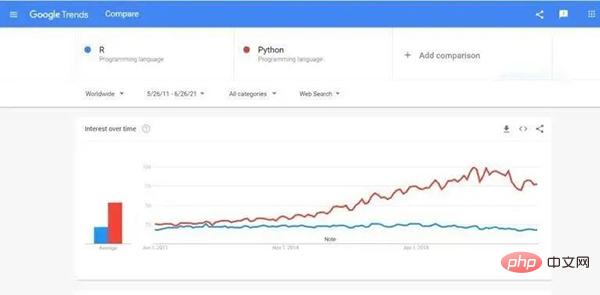 Backend Development
Backend Development
 Python Tutorial
Python Tutorial
 Python or R: Which programming language is better for data science?
Python or R: Which programming language is better for data science?
Python or R: Which programming language is better for data science?

A little background on R
R is a programming language and analysis tool developed by Ross Ihaka and Robert Gentleman and first introduced in 1993. At the same time, it is also a free open source software with a rich statistical and graphical technology library.
R is one of the most used tools by analysts, statisticians, and researchers for retrieving, cleaning, analyzing, visualizing, and presenting data. It is used by many industries such as IT, banking, healthcare, and finance. R.
Purpose
- Data scientists can use the R programming language to collect data, perform statistical analysis, and produce visualizations.
- It can be used for graphical representation.
- R can be used for both machine learning and deep learning.
- It can also provide a sophisticated statistical tool for financial operations and calculations, R and its libraries can implement moving averages, stock market modeling and financial KDD.
- It also implements statistical methods such as linear and nonlinear modeling.
Statistical Computing: R is the most widely used programming language among statisticians. It helps statisticians with manipulation, collection, cleaning and analysis. It also has charting capabilities and produces interesting visuals from any recording.
Machine Learning: It includes libraries for some basic machine learning tasks, such as linear and nonlinear regression, decision trees, etc. You can use R to create machine learning algorithms in finance, retail, marketing, and healthcare.
A little background about Python
It is a well-known computer language and a widely used, interpreted, object-oriented programming language. Invented by Guido van Rossum and first released on February 20, 1991. It can be used for a variety of programming and software development in addition to web development, and can be used to create a complete end-to-end process.
Use
- It can be used for BDA management and complex mathematical calculations.
- It can connect to the database system, or read and edit files.
- It is suitable for software development, business applications, audio, video, back-end networking, mobile application development, etc.
- It enables analysts to generate Excel reports in less time.
Analysis: Python is very convenient for analysis. For example, if a database contains millions of rows and columns, extracting information from this data can be difficult and time-consuming. This is where libraries like Pandas, NumPy, and SciPy come in to get the job done quickly.
Extraction: Because data is not always available, we need to get it from the network. In this case, you can use the libraries Scrapy and Beautiful Soup to extract information from the Internet.
Graphical representation: Seaborn and Matplotlib libraries can create charts, pie charts, and other visual content.
Machine Learning: It also has a machine learning library. Scikit-Learn and PyBrain are one of these libraries that provide some fast machine learning and statistical modeling tools such as classification, regression, and clustering through an interface.
Benefits of Python
- Availability: Works on multiple systems (Windows, Mac, Linux, Raspberry Pi, etc.).
- Simple and easy: The syntax or words and symbols required for a computer program to work are intuitive and direct. They are actually English terms so it is readable. Relative to other technologies like C, Java, and C#, code execution time is reduced, so developers and software engineers can work longer.
- Libraries: They are a set of pre-assembled code that can be reused to reduce coding time. This saves you from having to write code from scratch.
- Flexibility: Compared to other languages such as Java, it provides flexibility and can solve problems that would otherwise be impossible to solve. It turns out that it is scalable.
Now that we have explored these two programming languages from various angles, the question “Which language is better for data science?” arises.
Choose Python or R?
The biggest difference between these two languages is the way they handle situations. Both open source languages receive large community support, and they are constantly expanding their libraries and tools.
However, a question you should ask yourself is, "What do you want to focus more on? Machine learning or statistical learning?"
Machine learning is a discipline of artificial intelligence, while statistics Learning is a branch of statistics. R is a statistical language, so it is a good fit in statistics. Anyone with a formal background in statistics can program in R because it is easy to understand. And Python is the best choice for machine learning. Large-scale applications are the focus of machine learning. Python seemed like an ideal choice because of its flexibility and scalability for use in production environments, especially when analytics must be connected to web applications.
Trend Analysis and Salary Comparison
As shown in the figure below, Python or R are the most popular search terms in the world. Trend-wise, Python has been more popular than R over the past decade.

According to PayScale.com, the average annual salary for Python developers in the United States is $79,395, while the average annual salary for R programs is $68,554 (as of this article’s publication).


Summary
Python is a powerful and adaptable programming language that can be used on a wide range of computers Scientific applications. R is a popular language for building analytics. In fact, both languages have certain advantages and significance in the field of data science.
However, before you choose which language to use, you should ask yourself the following questions:
- Are you interested in learning machines and artificial intelligence or statistical learning and analysis? ?
- What are the most popular tools in your field?
- Do you want to become an analyst with a deeper understanding of data visualization, or use it to integrate web applications?
- How long are you willing to spend to master a programming language?
All in all, it is never a bad idea to learn these two languages, because "the skills are not overwhelming" will only benefit you as a computer science engineer.
The above is the detailed content of Python or R: Which programming language is better for data science?. For more information, please follow other related articles on the PHP Chinese website!

Hot AI Tools

Undresser.AI Undress
AI-powered app for creating realistic nude photos

AI Clothes Remover
Online AI tool for removing clothes from photos.

Undress AI Tool
Undress images for free

Clothoff.io
AI clothes remover

AI Hentai Generator
Generate AI Hentai for free.

Hot Article

Hot Tools

Notepad++7.3.1
Easy-to-use and free code editor

SublimeText3 Chinese version
Chinese version, very easy to use

Zend Studio 13.0.1
Powerful PHP integrated development environment

Dreamweaver CS6
Visual web development tools

SublimeText3 Mac version
God-level code editing software (SublimeText3)

Hot Topics
 1381
1381
 52
52
 HTML: Is It a Programming Language or Something Else?
Apr 15, 2025 am 12:13 AM
HTML: Is It a Programming Language or Something Else?
Apr 15, 2025 am 12:13 AM
HTMLisnotaprogramminglanguage;itisamarkuplanguage.1)HTMLstructuresandformatswebcontentusingtags.2)ItworkswithCSSforstylingandJavaScriptforinteractivity,enhancingwebdevelopment.
 PHP and Python: Code Examples and Comparison
Apr 15, 2025 am 12:07 AM
PHP and Python: Code Examples and Comparison
Apr 15, 2025 am 12:07 AM
PHP and Python have their own advantages and disadvantages, and the choice depends on project needs and personal preferences. 1.PHP is suitable for rapid development and maintenance of large-scale web applications. 2. Python dominates the field of data science and machine learning.
 Detailed explanation of docker principle
Apr 14, 2025 pm 11:57 PM
Detailed explanation of docker principle
Apr 14, 2025 pm 11:57 PM
Docker uses Linux kernel features to provide an efficient and isolated application running environment. Its working principle is as follows: 1. The mirror is used as a read-only template, which contains everything you need to run the application; 2. The Union File System (UnionFS) stacks multiple file systems, only storing the differences, saving space and speeding up; 3. The daemon manages the mirrors and containers, and the client uses them for interaction; 4. Namespaces and cgroups implement container isolation and resource limitations; 5. Multiple network modes support container interconnection. Only by understanding these core concepts can you better utilize Docker.
 How is the GPU support for PyTorch on CentOS
Apr 14, 2025 pm 06:48 PM
How is the GPU support for PyTorch on CentOS
Apr 14, 2025 pm 06:48 PM
Enable PyTorch GPU acceleration on CentOS system requires the installation of CUDA, cuDNN and GPU versions of PyTorch. The following steps will guide you through the process: CUDA and cuDNN installation determine CUDA version compatibility: Use the nvidia-smi command to view the CUDA version supported by your NVIDIA graphics card. For example, your MX450 graphics card may support CUDA11.1 or higher. Download and install CUDAToolkit: Visit the official website of NVIDIACUDAToolkit and download and install the corresponding version according to the highest CUDA version supported by your graphics card. Install cuDNN library:
 Python vs. JavaScript: Community, Libraries, and Resources
Apr 15, 2025 am 12:16 AM
Python vs. JavaScript: Community, Libraries, and Resources
Apr 15, 2025 am 12:16 AM
Python and JavaScript have their own advantages and disadvantages in terms of community, libraries and resources. 1) The Python community is friendly and suitable for beginners, but the front-end development resources are not as rich as JavaScript. 2) Python is powerful in data science and machine learning libraries, while JavaScript is better in front-end development libraries and frameworks. 3) Both have rich learning resources, but Python is suitable for starting with official documents, while JavaScript is better with MDNWebDocs. The choice should be based on project needs and personal interests.
 MiniOpen Centos compatibility
Apr 14, 2025 pm 05:45 PM
MiniOpen Centos compatibility
Apr 14, 2025 pm 05:45 PM
MinIO Object Storage: High-performance deployment under CentOS system MinIO is a high-performance, distributed object storage system developed based on the Go language, compatible with AmazonS3. It supports a variety of client languages, including Java, Python, JavaScript, and Go. This article will briefly introduce the installation and compatibility of MinIO on CentOS systems. CentOS version compatibility MinIO has been verified on multiple CentOS versions, including but not limited to: CentOS7.9: Provides a complete installation guide covering cluster configuration, environment preparation, configuration file settings, disk partitioning, and MinI
 How to install nginx in centos
Apr 14, 2025 pm 08:06 PM
How to install nginx in centos
Apr 14, 2025 pm 08:06 PM
CentOS Installing Nginx requires following the following steps: Installing dependencies such as development tools, pcre-devel, and openssl-devel. Download the Nginx source code package, unzip it and compile and install it, and specify the installation path as /usr/local/nginx. Create Nginx users and user groups and set permissions. Modify the configuration file nginx.conf, and configure the listening port and domain name/IP address. Start the Nginx service. Common errors need to be paid attention to, such as dependency issues, port conflicts, and configuration file errors. Performance optimization needs to be adjusted according to the specific situation, such as turning on cache and adjusting the number of worker processes.
 How to operate distributed training of PyTorch on CentOS
Apr 14, 2025 pm 06:36 PM
How to operate distributed training of PyTorch on CentOS
Apr 14, 2025 pm 06:36 PM
PyTorch distributed training on CentOS system requires the following steps: PyTorch installation: The premise is that Python and pip are installed in CentOS system. Depending on your CUDA version, get the appropriate installation command from the PyTorch official website. For CPU-only training, you can use the following command: pipinstalltorchtorchvisiontorchaudio If you need GPU support, make sure that the corresponding version of CUDA and cuDNN are installed and use the corresponding PyTorch version for installation. Distributed environment configuration: Distributed training usually requires multiple machines or single-machine multiple GPUs. Place



